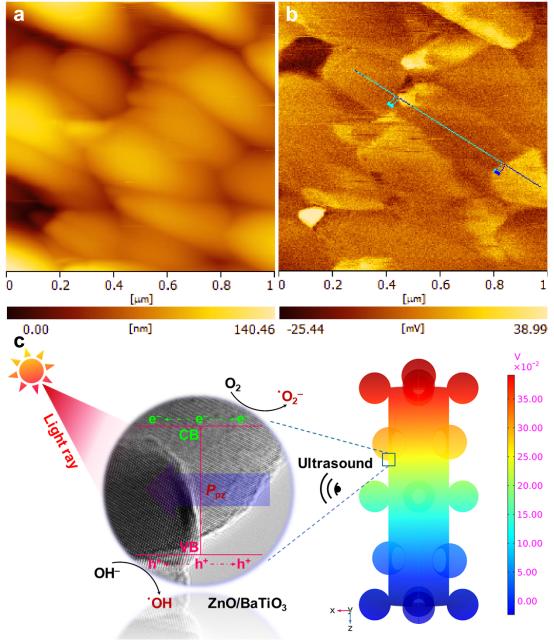On September 24, the international authoritative journalNano energypublished online the latest achievements of the professor Jiwei Zhai research group, school of materials science and engineering, Tongji University, on the mechanism of piezo-photoelectric polarization induced catalysis. This study systematically reveals the intrinsic relationship between the enhanced piezoelectric potential of homojunctions and the catalytic reaction rate, and explains the catalytic oxidation mechanism of the synergistic effect of piezoelectric potential and electrochemical potential on the rapid separation and transfer of charge carriers from a new perspective.
The title of the paper is "Piezophototronic effect in enhancing charge carrier separation and transfer in ZnO/BaTiO3heterostructures for high-efficiency catalytic oxidation". Tongji University is the first signatory, Shanghai Silicate Research Institute of Chinese Academy of Sciences is the joint signatory, Professor Jiwei Zhai is the corresponding author, and Xiaofeng Zhou, Ph.D. student of the university, is the first author.
Based on the coupling of piezoelectricity, photoexcitation and semiconductor characteristics, the piezophototronic effect has been widely used in the optimization and upgrading of LED, photodetector, photocell, solar cell and other photoelectric devices. However, with the application of electrons excited by piezophototronic effect in environmental purification, photolysis of water for hydrogen evolution or chemical synthesis, most of the related studies remain at the practical cognitive level or do not explore the intrinsic relationship between stimulated electrons and physical and chemical phenomena. It is against this background that it is particularly important to construct piezoelectric semiconductors with enhanced piezophototronic effect and excellent physical and chemical properties.

Figure 1.The PFM spectra (a, b) of ZnO/BaTiO3heterostructures and the mechanism of its catalytic oxidation (c).
In this paper, ZnO/BaTiO3piezoelectric semiconductor heterostructures with shorter reaction time and higher repeatability were designed and synthesized by solution impregnation thermal method. It is found that the piezoelectric potential difference produced by the heterostructure is significantly higher than that of pure BaTiO3and ZnO under ultrasound-initated pressure of 108Pa. In addition, ZnO/BaTiO3heterostructures exhibit a more negative flat band potential and a smaller charge transfer resistance than pure BaTiO3and ZnO. Therefore, driven by piezophototronic effect, the ZnO/BaTiO3heterostructure exhibits good catalytic oxidation performance for organic pollutants degradation. The corresponding reaction rate constant is 1.20×10–1min–1, which is 1.50 times as much as that of pure BaTiO3and 2.00 times as much as that of ZnO. This will provide a reference for understanding the relationship between macro-polarization and catalytic oxidation process, and also contribute to the development and application of multi-energy collection piezoelectric materials.
This work was jointly supported by the National Natural Science Foundation of China (No. 51772211) and the instrument development project of Chinese Academy of Sciences (No. ZDKYQ20180004).
Article link:https://authors.elsevier.com/a/1Zpha7soS7u1Or